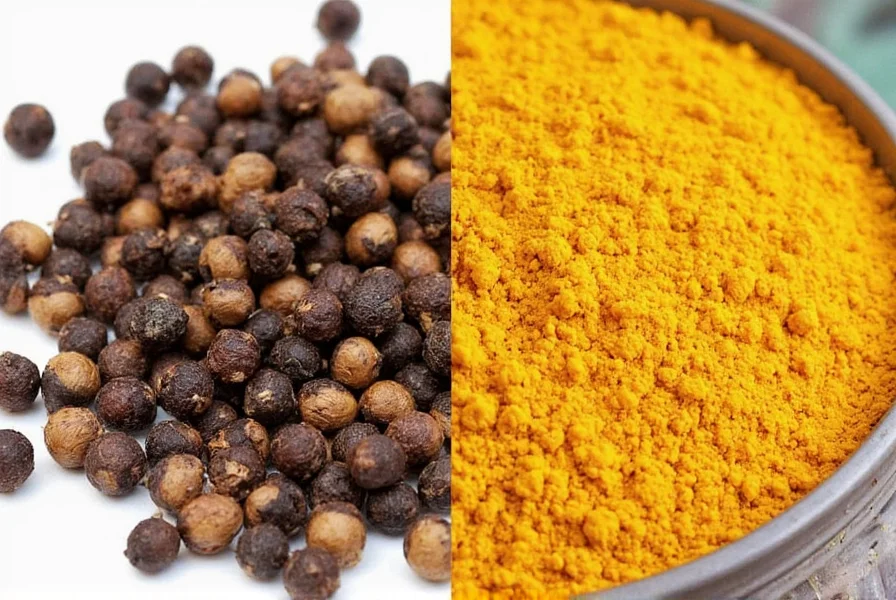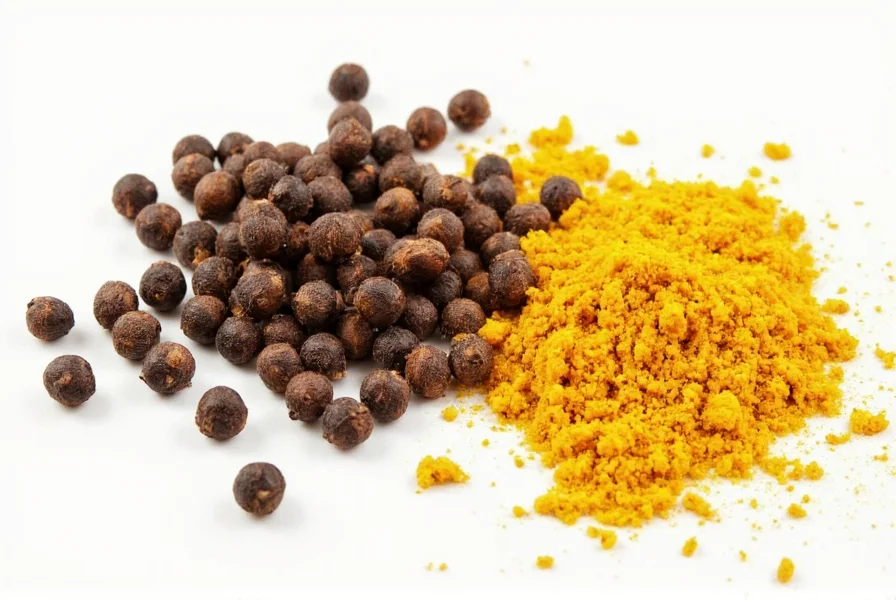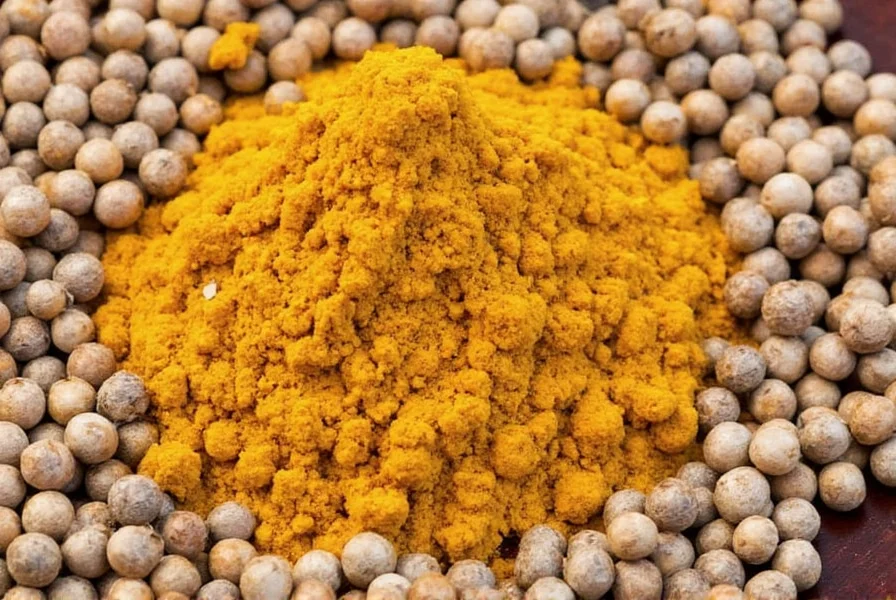When exploring the dynamic relationship between whole peppercorns and ground turmeric, it's essential to understand both spices individually before examining their combined benefits. Black peppercorns, the dried berries of the Piper nigrum vine, deliver a complex heat that evolves from floral to pungent. Turmeric, a rhizome in the ginger family, provides earthy, slightly bitter flavor with vibrant yellow color. Their most remarkable connection lies in piperine, the active compound in black pepper, which can increase curcumin absorption from turmeric by up to 2,000% according to multiple peer-reviewed studies.
The Science Behind the Spice Synergy
Understanding how black pepper enhances turmeric absorption requires examining the biochemical interaction. Curcumin, turmeric's primary active compound, has notoriously low bioavailability when consumed alone. Research published in Planta Medica demonstrated that piperine inhibits certain digestive enzymes and slows the breakdown of curcumin in the liver and intestinal wall. This allows more curcumin to enter the bloodstream and remain available for longer periods.
It's crucial to note that while this biochemical interaction is well-documented, peppercorns and turmeric health benefits should be discussed in culinary rather than medical terms. The spices work together to create more bioavailable compounds, but specific health outcomes vary among individuals and shouldn't be presented as guaranteed medical results.

Types of Peppercorns and Their Culinary Applications
Not all peppercorns deliver the same piperine content. Understanding different peppercorn varieties for turmeric pairing helps optimize your cooking:
| Peppercorn Type | Piperine Content | Best For Turmeric Pairing |
|---|---|---|
| Black Peppercorns | 5-9% | Ideal for most cooking applications |
| White Peppercorns | 3-6% | Light-colored sauces where black specks are undesirable |
| Green Peppercorns | 2-4% | Fresh applications, lower piperine content |
| Pink Peppercorns | Negligible | Not recommended for enhancing turmeric |
Maximizing Turmeric Benefits in Your Cooking
When incorporating peppercorns with turmeric in recipes, timing and preparation matter. For optimal curcumin absorption:
- Add freshly cracked black pepper (not pre-ground) near the end of cooking to preserve volatile compounds
- Combine with healthy fats like coconut oil or olive oil, as curcumin is fat-soluble
- Maintain a ratio of approximately 1/4 teaspoon black pepper to 1 teaspoon turmeric
- Consider adding a pinch of cinnamon, which may provide additional bioavailability benefits
Professional chefs specializing in traditional spice blending techniques with turmeric and pepper often toast whole peppercorns before grinding to enhance flavor complexity without diminishing piperine content. This technique works particularly well in curry preparations and spice rubs.
Practical Recipe Applications
Understanding how to use peppercorns and turmeric together in everyday cooking transforms ordinary dishes:
Golden Milk Enhancement: While traditional golden milk recipes include turmeric and black pepper, many home versions underutilize pepper. For maximum benefit, use freshly cracked pepper rather than pre-ground, and consider adding the pepper after heating to preserve volatile compounds.
Curry Base: When creating curry pastes, include whole black peppercorns in your spice toast before grinding. The heat releases essential oils while maintaining piperine integrity. This technique significantly improves the bioavailability of turmeric in your final dish.

Storage and Selection Guidelines
Proper storage affects the peppercorn and turmeric potency over time. Whole peppercorns retain piperine much longer than pre-ground pepper. Store peppercorns in airtight containers away from light and heat. Turmeric powder loses potency faster than whole root; for maximum curcumin content, consider grating fresh turmeric root and storing it in lemon juice to prevent oxidation.
When selecting high quality turmeric and peppercorns for cooking, look for vibrant orange-yellow color in turmeric (indicating higher curcumin content) and plump, heavy peppercorns with visible oil content. Avoid products with suspiciously bright yellow color, which may indicate adulteration with harmful dyes like metanil yellow.
Common Misconceptions Clarified
Several myths surround this spice pairing. While black pepper and turmeric absorption research is robust in laboratory settings, real-world applications require proper context. The 2,000% absorption increase refers to relative bioavailability, not absolute health outcomes. Additionally, the quality of both spices significantly impacts results—low-grade turmeric with minimal curcumin content won't benefit as much from pepper enhancement.
Understanding proper peppercorn to turmeric ratio for cooking prevents overpowering dishes. Many traditional Indian recipes naturally incorporate this ratio through centuries of culinary evolution, using approximately 1 part pepper to 4 parts turmeric by volume in many curry preparations.
Final Considerations
The pairing of peppercorns and turmeric represents one of culinary history's most scientifically validated combinations. When exploring authentic spice pairings with turmeric and black pepper, remember that traditional cooking methods often evolved to maximize both flavor and nutritional benefits. By understanding the science behind this pairing while respecting culinary traditions, home cooks can create dishes that are both delicious and optimized for ingredient synergy.
Whether you're preparing a simple turmeric-infused rice dish or an elaborate curry, incorporating freshly cracked black pepper at the appropriate stage transforms your cooking. This natural enhancement technique requires no special equipment or ingredients—just an understanding of how these two spices work together to create something greater than the sum of their parts.











 浙公网安备
33010002000092号
浙公网安备
33010002000092号 浙B2-20120091-4
浙B2-20120091-4